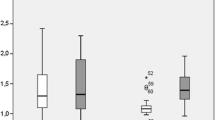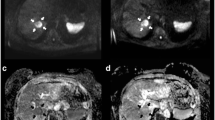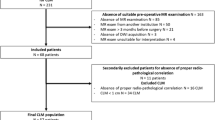Abstract
The purpose of this study was to investigate whether diffusion-weighted magnetic resonance imaging (DWI) is useful for early detection of the response of hepatic colorectal metastases to hepatic arterial infusion chemotherapy (HAIC) with 5-fluorouracil (5-FU). The subjects were 12 patients with hepatic colorectal metastases. The indwelling catheter for HAIC was placed in the hepatic artery, and 1000 mg/m2 5-FU was given repeatedly once a week. DWI was performed before and 9 days after HAIC. The minimum and mean apparent diffusion coefficient (ADC) values (minADC and meanADC) were measured. The relative change in ADC values (%ADC) and the relative change in tumor size on follow-up CT after 3 months (reduction ratio) were determined. Liver metastases were divided into two groups, responder and nonresponder. The correlation between %ADC and reduction ratio was determined, and %ADC was compared between the two groups. Eleven patients successfully completed HAIC over the 3-month period; 48 metastatic lesions were evaluated. Positive correlations were observed for relative change between %minADC and reduction ratio (r = 0.709) and between %meanADC and reduction ratio (r = 0.536). Both %minADC and %meanADC were significantly greater in the responder group than in the nonresponder group. With the threshold determined as < 3.5%, the receiver-operating curve analysis showed higher sensitivity and specificity values for %minADC (100% and 92.6%, respectively) than for %meanADC (66.7% and 74.1%, respectively). In conclusion, the relative change in minimum ADC values on DWI may be useful for early detection of the response of liver metastases to HAIC with 5-FU.







Similar content being viewed by others
References
Meyerhardt JA, Mayer RJ (2005) Systemic therapy for colorectal cancer. N Engl J Med 352:476–487
Mocellin S, Pilati P, Lise M, Nitti D (2007) Meta-analysis of arterial infusion for unresectable liver metastases from colorectal cancer: the end of an era? J Clin Oncol 25:5649–5654
Kemeny NE, Niedzwiecki D, Hollis DR et al (2006) Hepatic arterial infusion versus systemic therapy for hepatic metastases from colorectal cancer: a randomized trial of efficacy, quality of life, and molecular markers (CALGB9481). J Clin Oncol 24:1395–1403
Iguchi T, Arai Y, Inaba et al (2008) Chemotherapy through a port-catheter system as preoperative initial therapy in patients with advanced liver dysfanction due to synchronous and unresectable liver metastases from colorectal cancer. CardioVasc Interv Radiol 31:86–90
Therasse P, Arbuck SG, Eisenhauer EA et al (2000) New guidelines to evaluate the response to treatment in solid tumors: European Organization for Research and Treatment of Cancer, National Cancer Institute of the United States, National Cancer Institute of Canada. J Natl Cancer Inst 92:205–216
Thoeny HC, De Keyzer F, Chen F et al (2005) Diffusion-weighted MR imaging in monitoring the effect of a vascular targeting agent on rhabdomyosarcoma in rats. Radiology 234:756–764
Mardor Y, Roth Y, Lidar Z et al (2001) Monitoring response to convection-enhanced taxol delivery in brain tumor patients using diffusion-weighted magnetic resonance imaging. Cancer Res 61:4971–4973
Chenevert TL, Stegman LD, Taylor JM et al (2000) Diffusion magnetic resonance imaging: an early surrogate marker of therapeutic efficacy in brain tumors. J Natl Cancer Inst 92:2029–2036
Arai Y, Takeuchi Y, Inaba Y (2007) Percutaneous catheter placement for hepatic arterial infusion chemotherapy. Tech Vasc Interv Rad 10:30–37
Tanaka T, Arai Y, Inaba Y et al (2003) Radiologic placement of side-hole catheter with tip fixation for hepatic arterial infusion chemotherapy. J Vasc Interv Radiol 14:63–68
Seki H, Ozaki T, Shiina M (2008) Side-hole catheter placement for hepatic arterial infusion chemotherapy in patients with liver metastases from colorectal cancer: long-term treatment and survival benefit. AJR 190:111–120
Arai Y, Inaba Y, Takeuchi Y, Ariyoshi Y (1997) Intermittent hepatic arterial infusion of high-dose 5FU on a weekly schedule for liver metastases from colorectal cancer. Cancer Chemother Pharmacol 40:526–530
Liapi E, Geschwind JF, Vossen JA et al (2008) Functional MRI evaluation of tumor response in patients with neuroendocrine hepatic metastasis treated with transcatheter arterial chemoembolization. AJR 190:67–73
Rhee TK, Naik NK, Deng J et al (2008) Tumor response after yttrium-90 radioembolziation for hepatocellular carcinoma: comparison of diffusion-weighted functional MR imaging with anatomic MR imaging. J Vasc Interv Radiol 19:1180–1186
Cui Y, Zhang XP, Sun YS, Tang L, Shen L (2008) Apparent diffusion coefficient: potential imaging biomarker for prediction and early detection of response to chemotherapy in hepatic metastases. Radiology 248:894–900
Higano S, Yun X, Kumabe T et al (2006) Malignant astrocytic tumors: clinical importance of apparent diffusion coefficient in prediction of grade and prognosis. Radiology 241:839–846
Outwater E, Tomaszewski JE, Daly JM, Kressel HY (1991) Hepatic colorectal metastases: correlation of MR imaging and pathologic appearance. Radiology 180:327–332
Acknowledgment
We thank the Japanese Society of Implantable Port Assisted Regional Treatment (JSIPART) for assistance with submission of this article.
Author information
Authors and Affiliations
Corresponding author
Rights and permissions
About this article
Cite this article
Marugami, N., Tanaka, T., Kitano, S. et al. Early Detection of Therapeutic Response to Hepatic Arterial Infusion Chemotherapy of Liver Metastases from Colorectal Cancer Using Diffusion-Weighted MR Imaging. Cardiovasc Intervent Radiol 32, 638–646 (2009). https://doi.org/10.1007/s00270-009-9532-8
Received:
Revised:
Accepted:
Published:
Issue Date:
DOI: https://doi.org/10.1007/s00270-009-9532-8




